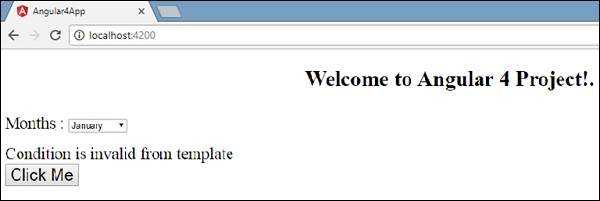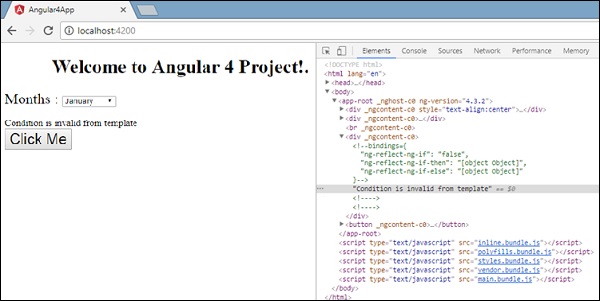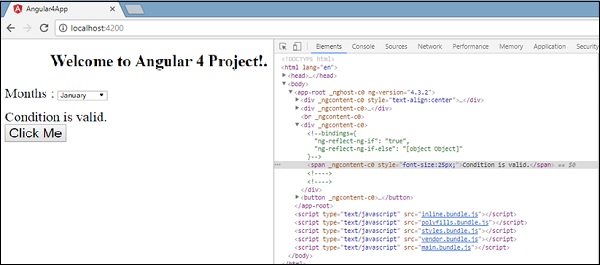
- Angular 4 教程
- Angular 4 - 首頁
- Angular 4 – 概述
- Angular 4 – 環境設定
- Angular 4 – 專案設定
- Angular 4 – 元件
- Angular 4 – 模組
- Angular 4 – 資料繫結
- Angular 4 – 事件繫結
- Angular 4 - 模板
- Angular 4 – 指令
- Angular 4 – 管道
- Angular 4 – 路由
- Angular 4 – 服務
- Angular 4 – Http 服務
- Angular 4 – 表單
- Angular 4 – 動畫
- Angular 4 – 材料
- Angular 4 – CLI
- Angular 4 – 示例
- Angular 4 有用資源
- Angular 4 - 快速指南
- Angular 4 - 有用資源
- Angular 4 - 討論
Angular 4 - 模板
Angular 4 使用 <ng-template> 作為標籤,而不是 Angular 2 中使用的 <template>。Angular 4 將 <template> 更改為 <ng-template> 的原因是 <template> 標籤與 HTML 標準標籤 <template> 之間存在命名衝突。未來它將完全棄用。這是 Angular 4 的主要變化之一。
現在讓我們結合if else 條件使用模板,並檢視輸出。
app.component.html
<!--The content below is only a placeholder and can be replaced.-->
<div style = "text-align:center">
<h1>
Welcome to {{title}}.
</h1>
</div>
<div> Months :
<select (change) = "changemonths($event)" name = "month">
<option *ngFor = "let i of months">{{i}}</option>
</select>
</div>
<br/>
<div>
<span *ngIf = "isavailable;then condition1 else condition2">Condition is valid.</span>
<ng-template #condition1>Condition is valid from template</ng-template>
<ng-template #condition2>Condition is invalid from template</ng-template>
</div>
<button (click) = "myClickFunction($event)">Click Me</button>
對於 Span 標籤,我們添加了帶有else 條件的if 語句,並將呼叫模板 condition1,否則呼叫 condition2。
模板的呼叫方式如下:
<ng-template #condition1>Condition is valid from template</ng-template> <ng-template #condition2>Condition is invalid from template</ng-template>
如果條件為真,則呼叫 condition1 模板,否則呼叫 condition2。
app.component.ts
import { Component } from '@angular/core';
@Component({
selector: 'app-root',
templateUrl: './app.component.html',
styleUrls: ['./app.component.css']
})
export class AppComponent {
title = 'Angular 4 Project!';
//array of months.
months = ["January", "February", "March", "April",
"May", "June", "July", "August", "September",
"October", "November", "December"];
isavailable = false;
myClickFunction(event) {
this.isavailable = false;
}
changemonths(event) {
alert("Changed month from the Dropdown");
console.log(event);
}
}
瀏覽器中的輸出如下:

變數isavailable 為 false,因此列印 condition2 模板。如果單擊按鈕,則將呼叫相應的模板。如果您檢查瀏覽器,您會看到 DOM 中從未出現 span 標籤。以下示例將幫助您理解這一點。

如果您檢查瀏覽器,您會看到 DOM 中沒有 span 標籤。DOM 中只有Condition is invalid from template。
HTML 中的以下程式碼行將幫助我們在 DOM 中獲取 span 標籤。
<!--The content below is only a placeholder and can be replaced.-->
<div style = "text-align:center">
<h1>
Welcome to {{title}}.
</h1>
</div>
<div> Months :
<select (change) = "changemonths($event)" name = "month">
<option *ngFor = "let i of months">{{i}}</option>
</select>
</div>
<br/>
<div>
<span *ngIf = "isavailable; else condition2">Condition is valid.</span>
<ng-template #condition1>Condition is valid from template</ng-template>
<ng-template #condition2>Condition is invalid from template</ng-template>
</div>
<button (click)="myClickFunction($event)">Click Me</button>
如果我們刪除 then 條件,我們將在瀏覽器中得到“Condition is valid” 訊息,並且 span 標籤也出現在 DOM 中。例如,在app.component.ts 中,我們將isavailable 變數設定為 true。

廣告